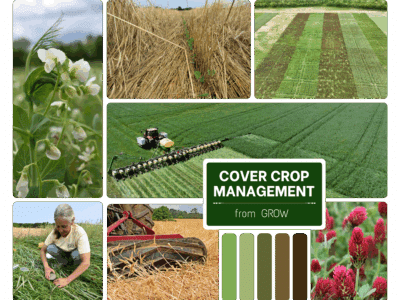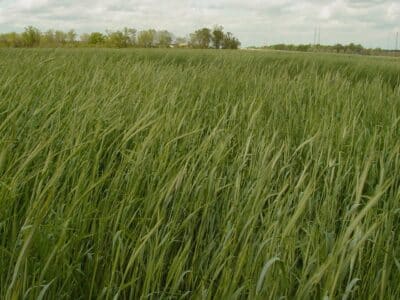ROCKVILLE, Md. — A group of more than 40 EPA scientists hit the road on September 13, 2022, for a farm tour of southern Maryland, sponsored by the Weed Science Society of America (WSSA).
The tour, which stopped at two farms, aimed to give these agency scientists an on-the-ground, regional perspective on herbicide-resistant weeds and farmers’ weed management and conservation efforts. A lunchtime discussion with a panel of local crop advisors also provided a chance for the agency to learn about the real-world implications of EPA’s new commitment to creating pesticide labels that fully comply with the Endangered Species Act (ESA).
Here are the highlights of the tour, which was organized by University of Delaware Extension Weed Scientist Mark VanGessel, in collaboration with University of Maryland Extension.
CONSERVATION EFFORTS ON DISPLAY AT PERSISTENCE CREEK FARM
On Persistence Creek Farm, near Faulkner, Maryland, EPA employees met father-son farm owners Francis and Kevin Warring, as well as Wayne Hancock, who leases and farms their cropland with his brother David. The farm includes a cash-crop mix of corn, soybeans, sorghum and winter wheat used as a fall cover crop. The family also runs a crab-and-oyster business and manages 100 acres of timber.
In 2021, Persistence Creek Farm was the first Maryland farm to receive the Leopold Conservation Award, which recognizes farmers, ranchers and forestland owners for excellent stewardship of their land, water and wildlife habitat.
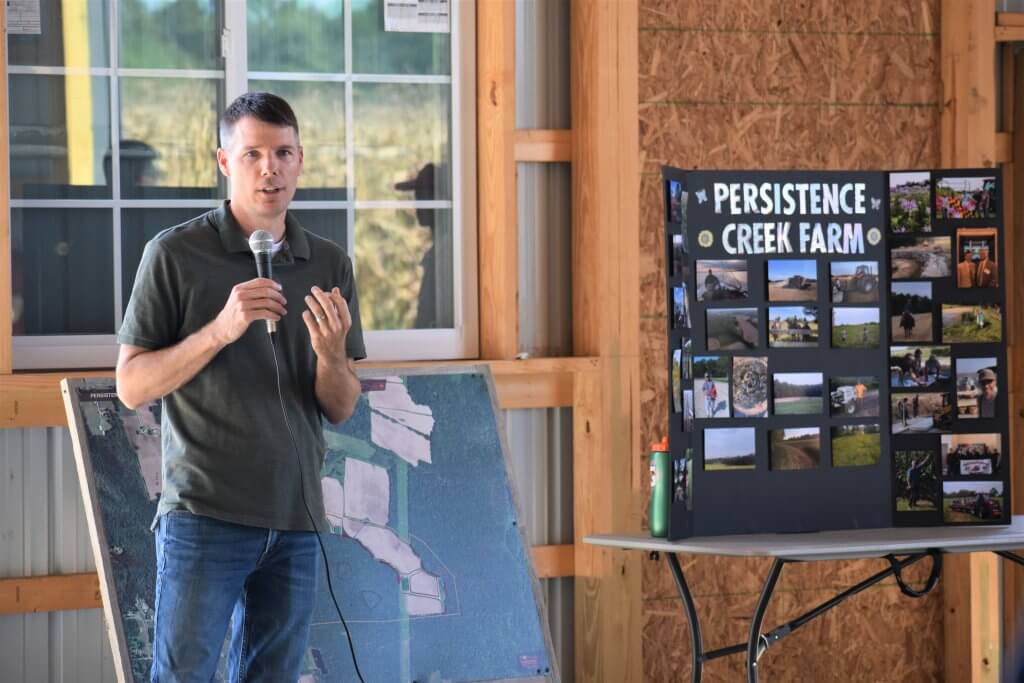
Warring spoke to the group about the conservation practices his family has adopted, such as no-till and cover crops. The tour group was able to see the riparian buffer that lined his soybean field nearby. Filled with trees, shrubs and plants, it created a 50-foot zone of protection for the stream bordering the field. Warring also spoke of several acres devoted to native wildflower and grassland habitats, which help lure deer – a major pest for Maryland crop farmers – away from their cash crops.

Warring credited local University of Maryland (UMD) Extension county agents and his local Natural Resources and Conservation Service (NRCS) office with helping his farm navigate and implement these practices. He also highlighted the contribution of cost-share programs from the NRCS, which made these conservation practices financially feasible.
“We have taken land out of production for these efforts, but our bottom line has improved,” Warring noted. “Cost-share incentives help you get there,” he added. “Maryland has been very forward-leaning with cost-share programs. Cover crops and no-till agriculture have taken off in Maryland, not only because of the Chesapeake Bay, but in part because of the ability to execute them here.”
HERBICIDES: ACCESS AND RESISTANCE CAUSE CONCERN
So what threats stand between Persistence Creek Farm and its conservation goals?
Herbicide-resistant weeds are becoming a major challenge to manage in a no-till operation, as Alan Leslie, UMD Extension County Agent for Charles County, explained to the group.
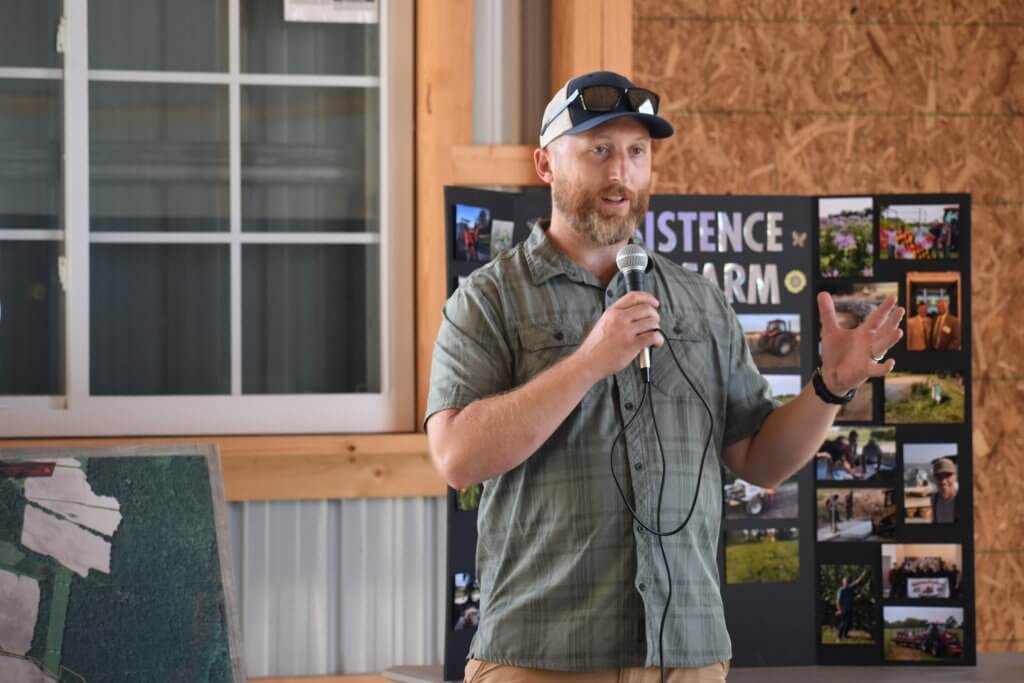
Herbicide-resistant Italian ryegrass is causing problems in small grain fields, and in soybean fields, herbicide-resistant Palmer amaranth is a major threat to weed control. Some farmers are turning back to tillage to control these stubborn weeds, but the Hancocks are dead set against that.
“I’ll quit farming before I go back to moldboard plowing,” Wayne Hancock told the group. The Hancocks now use the dicamba-tolerant Xtend soybean system, which enables them to spray dicamba on glyphosate-resistant Palmer amaranth. However, the June 30th cutoff date on the federal label takes that option off the table for double-crop soybeans, which are often planted as late as mid-July.
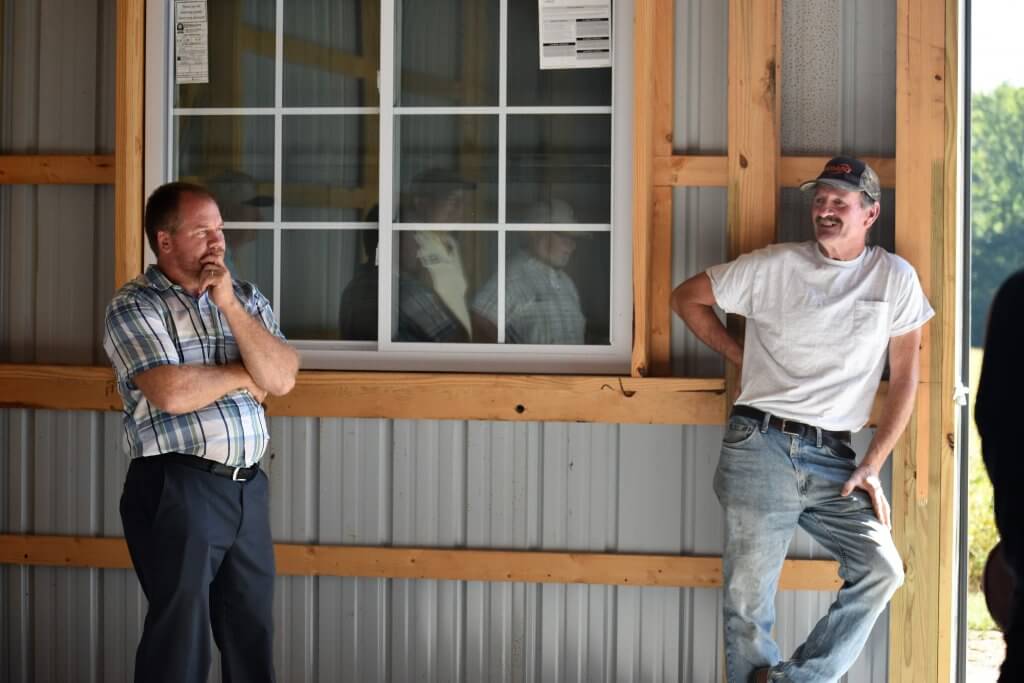
The complexity of the over-the-top dicamba labels also makes applying them difficult, added Ben Beale, UMD Extension County Agent for St. Mary’s County. Keeping up with the complicated tank mix procedure and record keeping is tricky, especially for farmers in southern Maryland, who typically manage a large number of small fields, the Extension agents and weed specialists noted.
The required in-field buffers for mitigations, for example, can carve out the majority of a small-acre field, Leslie explained. “And there’s no geometric name for some of these field’s shapes,” VanGessel said of the region’s many irregularly shaped fields. “Which side of the field is the downwind side is not always clear.”
There is more flexibility with the Enlist soybean system, which allows applications of over-the-top 2,4-D-choline products and glufosinate, as well as the XtendFlex system, which adds glufosinate tolerance to Xtend soybeans, Leslie added.
“Farmers need all these tools in the toolkit,” UMD Extension County Agent Dave Myers told the group. “I’m hoping that EPA will always take a look at the reality of the situation for resistance management…We can’t lose these tools.”
A final, looming threat to conservation practices such as no-till cropping and cover crop use is inflation and the soaring costs of inputs, such as herbicides and diesel fuel, Warring and Hancock noted. “Ultimately, the farmer’s bottom line is always the deciding factor,” Warring said.
STEVE WALTER TALKS WEED CONTROL
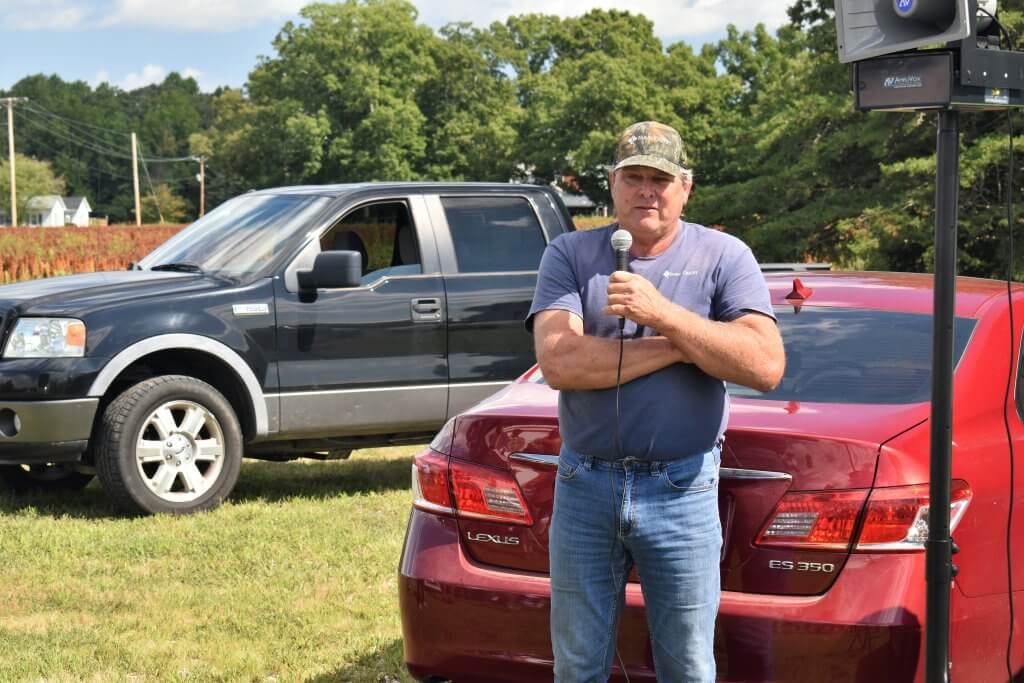
At the second farm stop, the EPA group met Steve Walter, who raises a wide diversity of crops, vegetables and ornamentals on H&S Farms in Hughesville, Maryland. Pumpkins, tomatoes, sweet corn and green beans take up a lot of the farm’s acreage, but they also grow grain crops such as soybeans and sorghum.
The addition of sorghum acres were actually driven by the intense and persistent deer damage to his soybean fields every year, Walter said. He estimated they can lose $70,000 to $80,000 a year to deer feeding in soybean fields.
Walter is dealing with a number of weed issues. Glyphosate-resistant pigweed was his farm’s first introduction to herbicide-resistance, and now they also battle multi-herbicide-resistant common ragweed. It appears resistant to glyphosate and ALS herbicides, and Walter suspects atrazine – his most important herbicide tool at the moment – is starting to lose some effectiveness, too.
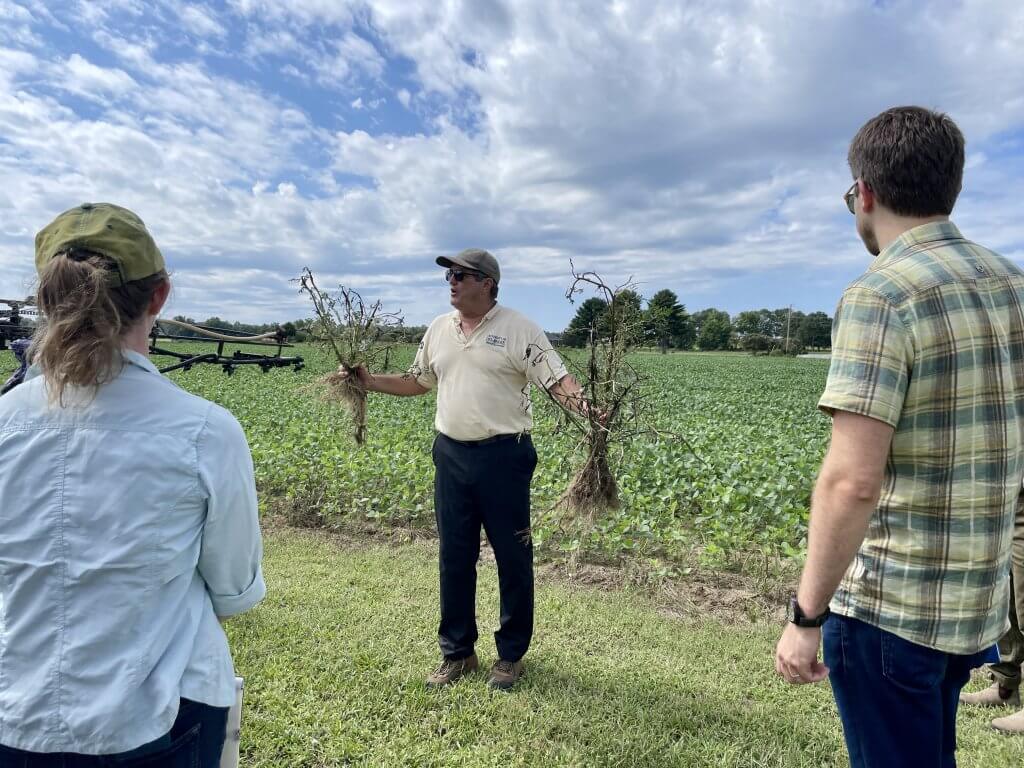
Walter uses the dicamba-tolerant Xtend soybean system to manage weeds. He said he has minimized drift problems by picking the fields he sprays very carefully, keeping in mind his own vegetable fields and neighboring Enlist fields, which have increased in recent years.
Walter showed the group his John Deere 4700 sprayer, with a Trimble 250 GPS navigational system. He is able to shut off sections of the boom manually when he is spraying to avoid overlaps. The sprayer is also equipped with Flow Meters, which are designed to change the rate of chemical output according to the sprayer’s speed.
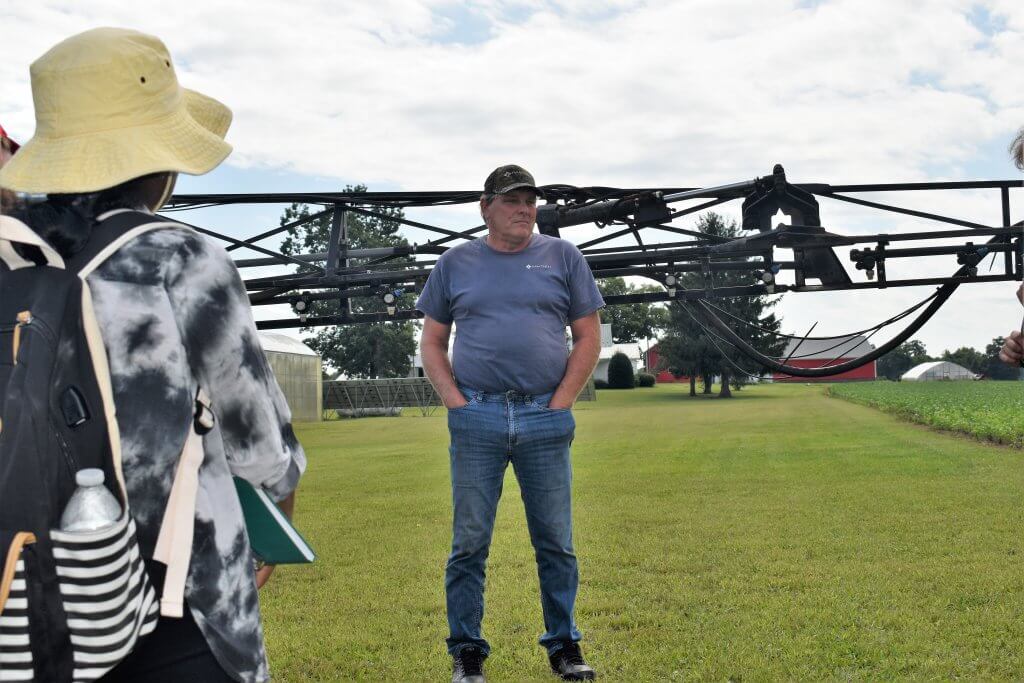
His favorite weed management tactic, however, is a healthy, fast-developing crop. “A good-growing crop is the best weed control,” he explained, since they canopy quickly and out-compete germinating weeds in between the rows.
When asked to name the biggest threat to his operation, Walter first mentioned soaring input prices. Glyphosate, for example, has increased from $10 to $15 per gallon a couple years ago to anywhere from $50 to $75 per gallon today. Fertilizer prices have also skyrocketed and he estimates that they cost him 200% more this year than in previous years. Nitrogen alone can cost him up to $106 per acre.
Walter also mentioned his concern about legal action against pesticides, recalling the Ninth Circuit Court of Appeals vacating over-the-top dicamba labels overnight in June 2020. The uncertainty of continued access is stressful, he said.
“I can’t control it, or know what policy will look like in the future,” he said.
LUNCHTIME PANEL CONVERSATION ON HERBICIDE LABELS AND PICK LISTS
With a panel of three local crop advisors assembled at lunchtime, EPA employees got a chance to learn how new herbicide labels, designed to comply fully with the Endangered Species Act, might actually work in the mid-Atlantic region.
Specifically, the group analyzed the new labels of Enlist herbicides and EPA’s recently proposed label changes for atrazine, which both contain a new section called “pick lists.”
These pick lists contain a number of mitigation measures designed to limit runoff, with each measure assigned a certain number of credits. Applicators are instructed to make sure that each field, depending on its hydrologic soil group, hits the required number of credits to spray each herbicide.
For example, on a field with soils classified as hydrologic group A or B, an applicator would need to use enough mitigation measures to equal 4 credits, in order to spray Enlist One on that field.
COMPLICATED LABELS AHEAD
The panel of crop advisors stressed to EPA that the new pick lists would be difficult to comply with, especially given that many growers do not know the hydrologic soil groups of each field they rent or own. Soil groups may even vary within the same field, they added.
The crop advisors also pointed out that in the mid-Atlantic region, it’s common for farmers to manage a large number of small fields, some only an acre or less in size. Most spray applications now involve multiple herbicides in a single tank mix, as well.
As a result, maintaining and tracking mitigation requirements from field to field, by individual herbicide, is likely to be difficult for farmers to accomplish and confusing for commercial applicators, the panel said.
SIMPLER LABELS MAY BE MORE RESTRICTIVE
EPA employees explained to the panel that despite their complicated set-up, the pick lists are designed to help growers maintain access to critical herbicides such as Enlist and atrazine.
At issue is EPA’s new commitment to making all pesticide labels fully comply with the Endangered Species Act, which requires the agency to consider how a herbicide might affect every animal, plant and critical habitat that is federally listed as endangered or threatened. The goal is for pesticide labels to be safer from legal challenges over their risks to endangered species.
Other than pick lists, label options that EPA has to choose from include banning a herbicide’s use in entire counties where an endangered species or critical habitat exists, or reducing the labeled rates of a herbicide.
The panel acknowledged that many farmers are not aware of these impending changes to pesticide labels, nor familiar with the Endangered Species Act. Knowing that the addition of pick lists to labels is meant to keep access to these herbicides available to them is important information for farmers to have, they added.
WHAT WORKS IN THE MID-ATLANTIC
Overall, among the pick lists for atrazine and Enlist herbicides, the crop advisor panel concluded that these measures are manageable options for mid-Atlantic growers:
- vegetative filter strips
- cover crops
- contour buffer strips and terraces (but only in parts of Pennsylvania)
- grassed waterways
- irrigation management (but only on the Eastern Shore, where irrigation is fairly common)
The panel asked EPA to consider the potential of other measures, such as adjuvants, pulse modulation sprayers and variable rate herbicide applications. They also asked for consideration of leaf absorption rates of each chemical, which can affect how much of a herbicide is vulnerable to runoff, which EPA noted would require new data for its models.
Finally, the EPA reminded the panel that the public is free to comment on the proposed pick list for atrazine, which varies by watershed, through October 7, 2022, here: https://www.regulations.gov/document/EPA-HQ-OPP-2013-0266-1627
Story and photos by Emily Unglesbee, GROW
